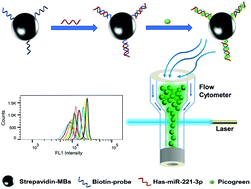A versatile magnetic bead-based flow cytometric assay for the detection of thyroid cancer related hsa-miR-221-3p in blood and tissues†
Abstract
In vitro detection of low abundance biomolecules including microRNAs (miRNAs) is essential to biological research and early clinical diagnosis. In this work, a versatile magnetic bead (MB)-based flow cytometric assay was developed for the detection of hsa-miR-221-3p, which is strongly associated with papillary thyroid carcinoma (PTC). In the presence of hsa-miR-221-3p, the complementary DNA probe attached to the surface of MBs is hybridized with the target to form DNA/RNA heteroduplexes. After the recognition of the DNA/RNA heteroduplexes by PicoGreen, the fluorescence signals of each MB were readily detected using a flow cytometer. This assay can selectively detect hsa-miR-221-3p with a detection limit of 2.1 pM. The practicality of the assay is demonstrated by the discrimination of thyroid cancer tissues from normal tissues, and a satisfactory result is obtained. Moreover, this assay can be rapidly carried out in one step at room temperature, providing a generic method for the sensitive detection of miRNAs in molecular diagnosis.

- This article is part of the themed collection: Analyst Recent HOT articles


 Please wait while we load your content...
Please wait while we load your content...